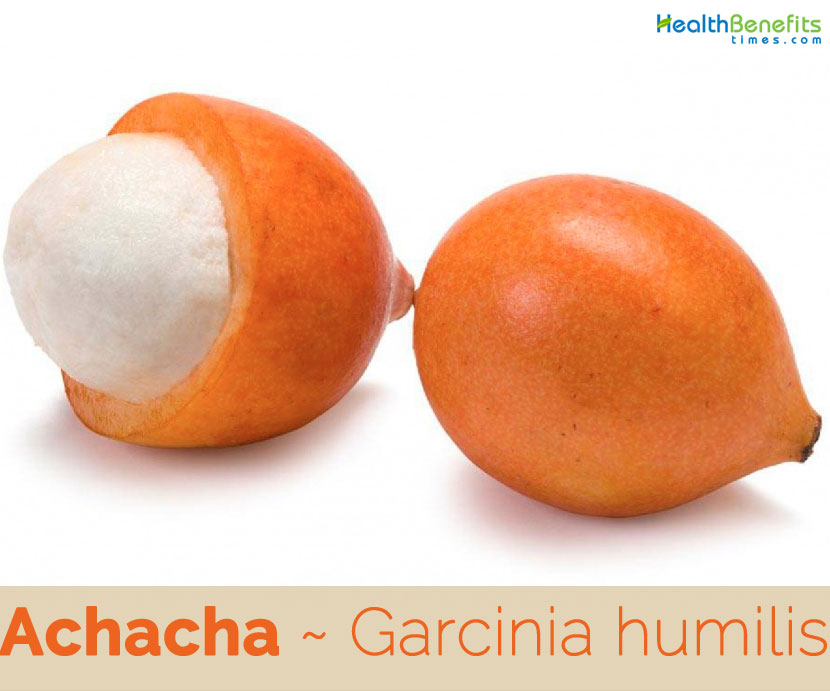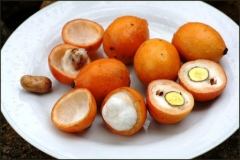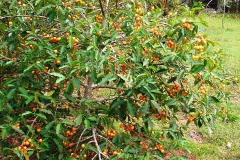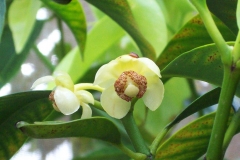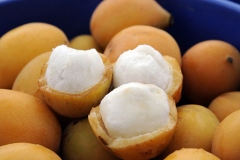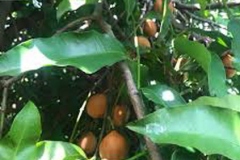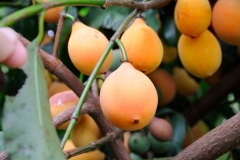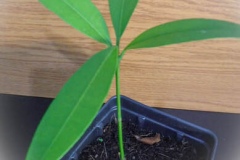Plant Description
Achacha is an evergreen shrub or small tree that grows about 6–10 m with pyramidal shaped canopy and stem of 40 cm diameter with a yellowish sap. The plant is found growing in sheltered aspects of woodland, often on limestone, at elevations of 150 – 900 meters and wet forests near the coast of Panama. The plant does best in moist, well drained, alluvial soils rich in organic matter. It is intolerant of saline soils and is moderately drought tolerant. Leaves are opposite, large, glossy dark-green, coriaceous, simple, and elliptic to lanceolate 15–28 cm long and 4–8 cm wide, with entire margin and acute to acuminate apex. Juvenile leaves are pinkish- bronze, turning yellowish-green then to dark green.
Flower
Flowers are hermaphrodite, 4-5 white flowers occur on 2 cm long pedicels. Hermaphrodite flowers are 17–36 mm long with, 20–34 stamens, 2 sepals, 4 white, imbricate petals and an ovoid ovary. Male flowers are 9.5–12 mm long, with 26–28 stamens and a vestigial ovary.
Fruit
Fertile flowers are followed by smooth ovoid to ellipsoid berry with hard thick skin. The fruit is similar in size and shape to an egg. It is up to 5.5–6 cm long and 4.4–5 cm across at the equatorial diameter and has an average weight of 50 grams. The fruits are bluish-green color when immature to a yellowish-orange and then changes to orange-reddish color as it ripens. Skin is firm and protective, yet quite easy to open. White interior flesh separates easily from the pericarp, containing 1-4 seeds. Seeds are brown, oval, poly embryonic, large 3.0–3.5 cm long and 1.5–2 cm wide surrounded in white acidic sweet pulp. Seeds exude yellow sap when cut.
Health benefits of Achacha
Listed below are few of the popular health benefits of consuming Achacha fruit
1. Lower Risk of Heart Disease, Heart Attack and Stroke
Achacha fruit consists of wonderful amount of potassium, and medical experts say that it’s something that can help keep high blood pressure at bay. Potassium does that by causing the blood vessels to widen, resulting in the lowering of the blood pressure. As a result, a person’s risk of having heart disease, heart attack and stroke may be lowered.
2. Cold or Flu
Achacha is very rich in vitamin C, which is an immune booster. This is the reason why adding it (and other vitamin C-rich fruits and vegetables) to your diet as regularly as possible can help lower your risk of ending up with an infection of the upper part of the respiratory system, such as the common cold and flu even while they’re in season!
3. Promote Regular Movement of the Bowels
Achacha is also packed with dietary fiber, and indigestible type of carbohydrates that offers a number of health benefits. One of those is the regular evacuation of the bowels. Fiber helps keep constipation at bay. Regular intake of achacha and other high-fiber foods is also known to help lower your risk of having hemorrhoids and colorectal cancer.
4. Slows Down the Aging
Vitamin C found in great amounts in achacha is also very good at slowing the aging process of the skin. It’s for the fact that the said nutrient is a powerful antioxidant proficient of neutralizing age-accelerating free radicals. Vitamin C is also needed for the creation of collagen, a substance that makes your skin firm and less prone to wrinkling and sagging.
5. Keep Birth Defects from Striking
Pregnant women are encouraged to eat good amounts of achacha most especially during first few months of being in the family way. That’s because this Brazilian fruit is a great source of foliate, a B vitamin proven to help prevent birth defects in babies, mainly neural tube defects that involve failure of the brain and spinal cord to develop properly.
6. Blood Sugar Regulation
Low sugar level and fiber in the Achacha produces good effects in the regulation of the blood sugar level. This produces good effects for the one suffering from diabetes.
Traditional uses and benefits of Achacha
- Fruit rind when made into a drink, help to suppress hunger and has been reported to be used for healing the skin.
- Sap is applied to the skin for its healing properties.
Culinary Uses
- White slightly acidic to sweet pulp is pleasantly mellow and refreshing and is eaten fresh out of hand when ripe.
- Pulp is also used in jams, beverages, sorbets and ice-cream.
- Rind is not bitter and is utilized for beverage and wine.
- Thin rind is extracted in a juicer to make a delicious, refreshing drink by adding sugar.
- Sweet and succulent edible pulp is used for making drinks and preserves.
- Fruit skin is also used to make a refreshing drink.
Other Facts
- In Trinidad, young trees have been cut, branches trimmed so the stem and shortened limbs form a natural hat-stand.
- During the fruiting season the fruits are available in local markets in Australia.
- Tree is a source of a hard wax.
- A kind of waxy resin exudes from nodes on the branches has a pleasant aroma and is used as the fuel in making torches.
- Reddish wood is used for common joinery etc.
References:
https://www.itis.gov/servlet/SingleRpt/SingleRpt?search_topic=TSN&search_value=822452#null
http://tropical.theferns.info/viewtropical.php?id=Garcinia+humilis
http://tn-grin.nat.tn/gringlobal/taxonomydetail.aspx?id=411005
https://en.wikipedia.org/wiki/Garcinia_humilis
https://plants.usda.gov/java/ClassificationServlet?source=display&classid=GARCI
https://npgsweb.ars-grin.gov/gringlobal/taxonomydetail.aspx?id=31093
Comments
| Achacha Quick Facts | |
|---|---|
| Name: | Achacha |
| Scientific Name: | Garcinia humilis |
| Origin | Bolivia and Guyana, Panama and in the Caribbean: Antilles, Dominica, Trinidad Grenada and Haiti |
| Colors | Bluish-green when young turning deep golden yellow to orange |
| Shapes | Smooth, ovoid to ellipsoid, 5.5–6 cm long by 4.4–5 cm across at the equatorial diameter, rind 0.8–1.5 mm thick |
| Flesh colors | White |
| Taste | Both bitter and sweet and is somewhat reminiscent of lemonade |
| Health benefits | Lower Risk of Heart Disease, Heart Attack and Stroke, Cold or Flu, Promote Regular Movement of the Bowels, Slows Down the Aging, Keep Birth Defects from Striking, Blood Sugar Regulation |
| Name | Achacha |
|---|---|
| Scientific Name | Garcinia humilis |
| Native | Bolivia and Guyana, Panama and in the Caribbean: Antilles, Dominica, Trinidad Grenada and Haiti |
| Common Names | Achacha, Bolivian Mangosteen, Hatsland Rheedia, Hatstand Tree, Low Garcinia, Wild Manimee, Wild mammee |
| Name in Other Languages | Bengali: Āchāchā (আছাছা) Bolivia : Shashairu, Pacurí, Ibaguazú, Cachicheruqui, Tiquidea, Achacha, Achachairú English: Bolivian mangosteen, Wild mammee French: Abricotier de St. Domingue, Garcinia-abricot Grenada : Abricot, Abricot Montagne, Abricot St. Domingue, Abricotier De St. Domingue, Bois Chica, Bois L’onguent, Bois Mulâtre, Garcinia Abricot Haiti : Abricot, Abricot Bâtard, Abricot Bord De Mer, Arbricotier De St-Domingue, Garcinia Abricot Kannada: Acācā (ಅಚಾಚಾ) Malayalam: Accācca (അച്ചാച്ച) Portuguese: Achachairu Spanish: Achacha, Achachairú |
| Plant Growth Habit | Evergreen shrub or small tree |
| Growing Climates | Sheltered aspects of woodland, often on limestone, at elevations of 150 – 900 metres. Wet forests near the coast of Panama |
| Soil | Does best in moist, well drained, alluvial soils rich in organic matter. It is intolerant of saline soils and is moderately drought tolerant |
| Plant Size | 6–10 m with pyramidal shaped canopy and stem of 40 cm diameter with a yellowish sap |
| Leaf | Opposite, large, glossy dark-green, coriaceous, simple, elliptic to lanceolate 15–28 by 4–8 cm, with entire margin and acute to acuminate apex. Juvenile leaves are pinkish- bronze, turning yellowish-green then to dark green |
| Flower | Hermaphrodite and male, both white and on with 2 cm long pedicels. Hermaphrodite flowers in axillary fascicle of 4–5 flowers flower 17–36 mm long with, 20–34 stamens, 2 sepals, 4 white, imbricate petals and an ovoid ovary. Male flowers 9.5–12 mm long, with 26–28 stamens and a vestigial ovary |
| Fruit Shape & Size | Smooth, ovoid to ellipsoid, 5.5–6 cm long by 4.4–5 cm across at the equatorial diameter, rind 0.8–1.5 mm thick |
| Fruit Color | Bluish-green when young turning deep golden yellow to orange |
| Fruit Skin | Tough, bitter rind |
| Flesh color | White |
| Seed | 2–3, brown, oval, poly embryonic, large 3.0–3.5 by 1.5–2 cm embedded in white acidic sweet pulp. Seeds exude yellow sap when cut |
| Propagation | By seed |
| Taste | Both bitter and sweet and is somewhat reminiscent of lemonade |
| Season | December to mid-March |
| Health Benefits |
|
____________ Scientific Classification
| Scientific name | |
|---|---|
| Kingdom | |
| Subkingdom | |
| Infrakingdom | |
| Superorder | <
|


